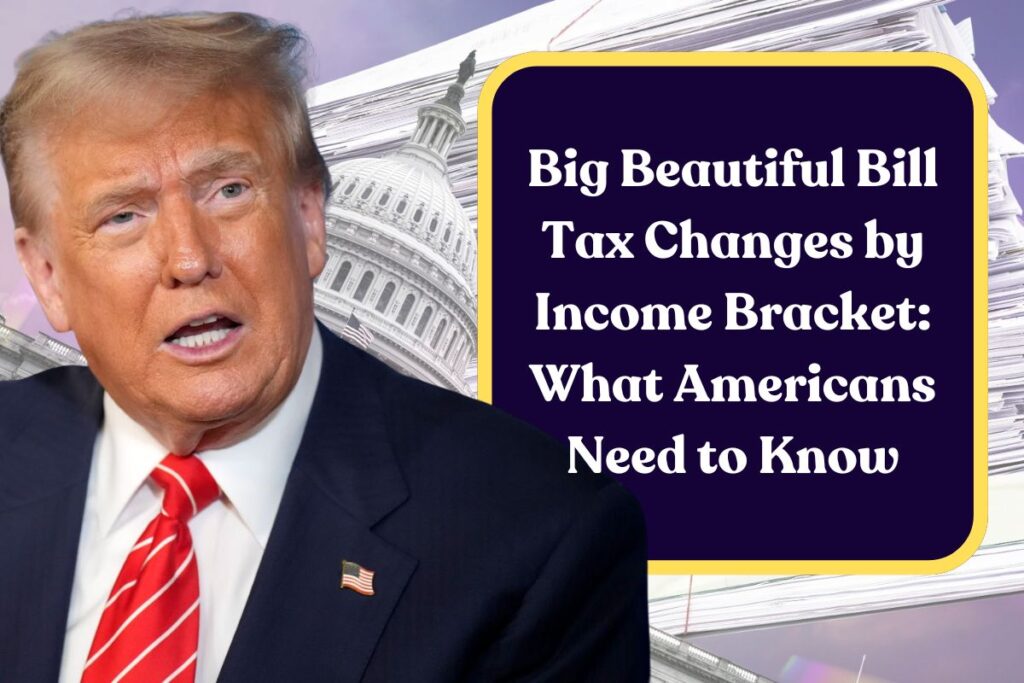Now, Big Beautiful Bill is especially recognized as the One Big Beautiful Bill Act, which has produced political sparklers across the country. The Big Beautiful Bill is promoted all over the US as a populist tax and spend set that makes strong the Trump-era cuts and brings new respite to everyday Americans.

According the several considerations of people, high earners are getting benefits from the program, and others with low-income households could end up worse off. Several plans are announced by the US president through the Bill. People are expecting a better era with the president’s Big Beautiful Bill.
Big Beautiful Bill Tax Changes by Income Bracket
Under the Big Beautiful Bill, Americans are getting several different effects this year. The US President represented this bill with a new strategy for all Americans. Here is a breakdown by income bracket of the bill.

High Earners ($200K+ Annual Income)
High-earner families are considered the primary beneficiaries of the program. USA Today quotes the Tax Policy Center, which approximations that more than two-thirds of the total tax relief will stream to those earning roughly $217000 or more. Usually, these families can face a cut of about $2800 in 2026.

Under the program, the authorities are doubling the further wealth protection of the estate tax exemption, now protecting legacies up to $14-15 million, and a higher SALT cap vital for landowners in high tax states increased from $10K to $30-40K.
Upper-Middle Earners ($100K – $200K)

The individuals who are in specific earning brackets of $100K to $200K can see benefits, although less dramatic. These income brackets can receive several additional bonuses, including expanded SALT reductions and a modest hike in the CTC (to $2200), but the range of benefits is lower than the top earners.
The Economic Times estimated that hardly 57% of the total benefit is focused on the households earning $217K +, and this group with less clear-cut developments.

Middle Class Households (Less than $100K)
Middle-class households with low income can get only a few benefits, but they have to face trade-offs. Under the act, employees who are making from tips and overtime will comfortable the removal from federal taxes on their salaries, and notice on American-made car loans (up to $10K) converted provisionally deductible. According to USA Today, those making amid $15K and $92.9K get just a $815 usual yearly cut, while lower-level employees receive much less.
Lower Income Households (Less than $50K)
Lower-income households will face great losses. Low-income families that earn less than $50K, they may lose around $700 to $1000 yearly due to the deduction in Medicaid and SNAP. According to the Congressional Budget Office (CBO) estimates that 7 to 10 million Americans could lose their Medicaid coverage as welfare work requirements constrict.

Who Wins and Who Lose?
Through the One Big Beautiful Bill, the US president offered several benefits to Americans that are largely available to high earners, lasting Trump-era separate and corporate cuts, an increased SALT cap, an extended CTC, and tip or overtime income, and car loan interest, all are focused in the $200K + bracket. With it, the lawmaking capital, these tax breakdowns by critical safety net plans. Medicaid and SNAP are facing a difficult situation with the high budget deduction, possibly causing millions to lose coverage or food benefits.
Work necessities added to Medicaid loom to eliminate low-income Americans en masse. The program has ascended back to student loans, several respite plans have been removed, refund caps have become harder, and fewer federal plans are available for Americans.
Who would benefit from the bill?
Many groups benefit from the bill. The bills especially provide benefits for the high-income households and several other groups. You can know the exact facts about the groups that benefit from the bill.
High-Income Households and Families with Children
The bill would extend tax cuts that the US president introduced during the first term. While Trump represents this as a benefit for the American people, some will get more benefits than others. Under the bill, those families can get benefits that have an annual income of $460000 or more.
If the bill does not approve, the CTC would drop from the current $2000 per child to $1000 in 2026. However, if the present version of the Senate bill is approved, then the CTC will forever upsurge to $2200. This is a slight upsurge from the $2500 in the form of the bill that the House agreed on.
Traditional Car Manufacturers
Developers of traditional petrol-driven cars might profit from the bill because the Senate form pursues to finish the tax credit for the purchase of electric vehicles, worth up to $7500, starting on September 30. This could be the main reason that customers do not want to purchase EVs, leveling the in the performance arena for cars that run on petrol or diesel.
Employees who receive tips
Under the bill, tips will not be taxed if this bill passes.
Presently, all employees who get tips are compulsory to report all tips taken more than $20 a month to their employers, and those supplementary salaries are taxed.
Who Would Lose Out from the bill?
Also, some groups would not get benefits from the bill.
Food Stamp recipients
According to the nonpartisan CBO, the Senate version of the bill estimates that the program will slash the food stamps program, called SNAP, by $68.6 billion over a decade.
Medicaid Beneficiaries
Under the bill, the Senate form of the bill suggests national backing cuts by $930 billion to Medicaid, the major program providing healthcare to low-income people. These are slashes to economic expenditures by 2034.
EV manufacturers
If the bill passes, the EV tax recognition would finish on September 30. The House version goals to close out the tax recognition by the conclusion of 2025.
Final Thoughts
The CBO expected that the Senate Form would increase the nationwide responsibility by $3.3 trillion from 2025 to 2034. Above the House version, the CBO projected a $2.4 trillion upsurge in the liability over a period. The present US nationwide liability stands at $36 trillion and signifies 122% of the country’s GDP.
| Homepage | BlackSea-Commission.org |






